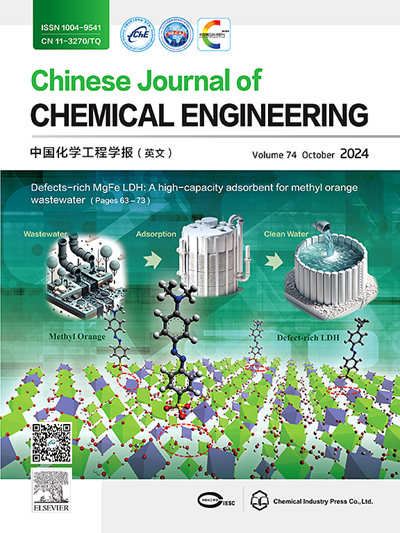铁掺杂Co3O4上的金纳米颗粒增强低温CO氧化
IF 3.7
3区 工程技术
Q2 ENGINEERING, CHEMICAL
引用次数: 0
摘要
采用溶胶沉积法,在fe掺杂的Co3O4上沉积2 ~ 5 nm的Au颗粒,合成了一系列Au/CoxFe3-xO4催化剂。Co/Fe摩尔比为2:1的Co2FeO4比Co3O4具有更高的比表面积、Co3+/Co2+比和氧空位含量。结果表明,它在CO氧化中表现出较好的性能,总转化温度(T100)为96℃。Au大大提高了所有CoxFe3-xO4样品的催化效率,其中0.2%Au/Co2FeO4催化剂在T100至73℃时进一步降低。在室温下对1%Au/CoxFe3-xO4催化剂进行了稳定性测试,结果表明fe掺杂后的失活速率减慢。Au/Co2FeO4催化CO氧化的反应途径遵循Mars-van Krevelen机理。本文章由计算机程序翻译,如有差异,请以英文原文为准。

Gold nanoparticles on Fe-doped Co3O4 for enhanced low-temperature CO oxidation
A series of Au/CoxFe3-xO4 catalysts was synthesized using the sol-deposition method by depositing 2–5 nm Au particles on Fe-doped Co3O4. Co2FeO4, with a Co/Fe molar ratio of 2:1, exhibited higher specific surface area, Co3+/Co2+ ratio, and oxygen vacancy content compared to Co3O4. As a result, it displayed better performance in CO oxidation, achieving a total conversion temperature (T100) of 96 °C. Au greatly improved the catalytic efficiency of all CoxFe3-xO4 samples, with the 0.2%Au/Co2FeO4 catalyst achieving a further decrease in T100 to 73 °C. Stability tests conducted at room temperature on the 1%Au/CoxFe3-xO4 catalysts demonstrated a slowed deactivation rate after Fe-doping. The reaction pathway for CO oxidation catalyzed by Au/Co2FeO4 followed the Mars-van Krevelen mechanism.
求助全文
通过发布文献求助,成功后即可免费获取论文全文。
去求助
来源期刊

Chinese Journal of Chemical Engineering
工程技术-工程:化工
CiteScore
6.60
自引率
5.30%
发文量
4309
审稿时长
31 days
期刊介绍:
The Chinese Journal of Chemical Engineering (Monthly, started in 1982) is the official journal of the Chemical Industry and Engineering Society of China and published by the Chemical Industry Press Co. Ltd. The aim of the journal is to develop the international exchange of scientific and technical information in the field of chemical engineering. It publishes original research papers that cover the major advancements and achievements in chemical engineering in China as well as some articles from overseas contributors.
The topics of journal include chemical engineering, chemical technology, biochemical engineering, energy and environmental engineering and other relevant fields. Papers are published on the basis of their relevance to theoretical research, practical application or potential uses in the industry as Research Papers, Communications, Reviews and Perspectives. Prominent domestic and overseas chemical experts and scholars have been invited to form an International Advisory Board and the Editorial Committee. It enjoys recognition among Chinese academia and industry as a reliable source of information of what is going on in chemical engineering research, both domestic and abroad.
 求助内容:
求助内容: 应助结果提醒方式:
应助结果提醒方式:


